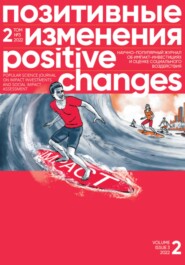 Полная версия
Полная версияПозитивные изменения. Том 2, № 3 (2022). Positive changes. Volume 2, Issue 3 (2022)
Yulia Vyatkina
DOI 10.55140/2782–5817–2022–2–3–29–34
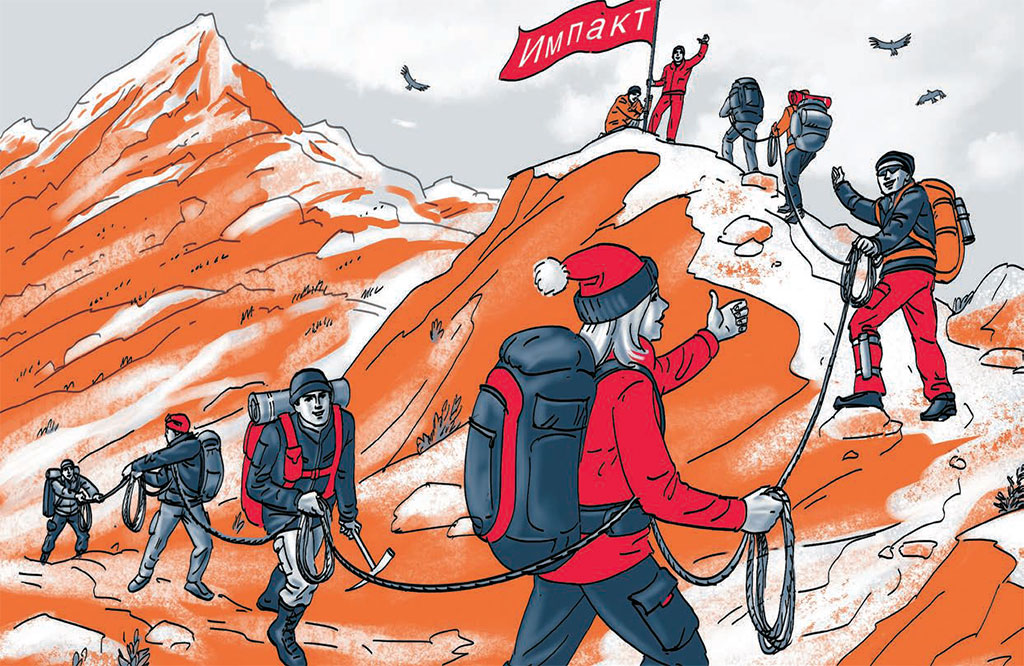
Social entrepreneurship remains a territory of opportunity in the times of crisis. Experts note that businesses that have not closed down during the pandemic are more adapted to the new economic environment. Impact investors are willing to continue supporting interesting projects; there is money in the impact investment market. The state also provides a wide range of opportunities. What other changes and trends exist in the development of social entrepreneurship was the topic of expert discussion at the opening of the “Start Differently” joint acceleration program of Rosbank and Impact Hub Moscow in September this year.

Yulia Vyatkina
Editor, Positive Changes Journal
ENDURING AND RESILIENT
As shown by a study conducted by the St. Petersburg State University’s Graduate School of Management and Impact Hub Moscow, social entrepreneurs proved to be more enduring and resilient during the COVID-19 pandemic than microenterprises and small businesses[23]. Virtually none closed shop. While the current economic situation in the country remains a challenge, those who survived the pandemic are now more adapted to the new environment, experts say.
Social entrepreneurs solve operational problems every day, often with no to stop and think about what and how they can improve and refine. The pandemic was precisely the kind of stop that enabled a very serious leap forward. The explanation is simple: people who work in social entrepreneurship originally came there not just to make money, but to solve a social problem. They carry a great burden of responsibility; they cannot abandon the people they care about, their beneficiaries, their clients. That is why they are forced to find new ways and internal resources to keep doing what they are doing.
Social projects often have no business model and no view of the future. Which means an experienced investor would not fund such an application.
The fact that none of the social entrepreneurs shut down their business during the pandemic and in the current situation is also confirmed by Lyubov Yermolayeva, co-founder of the BuySocial project[24].
“The response to the current crisis is similar to what happened in 2020. The first reaction is a shock, and then everyone realigns themselves to keep helping the vulnerable people they work for. Some may be facing some temporary financial difficulties. But actually all the 60 projects we are working with are still up and running. They are related directly to people from vulnerable groups and understand that in case of the crisis their customers would be even more vulnerable. Of course, social entrepreneurs cannot leave them alone, and have to continue their activities and mission,” says Lyubov Yermolayeva.
However, since BuySocial has many corporate clients, the service has been affected by the departure of international companies; yet, it hopes that Russian and international companies remaining in Russia will continue to support social entrepreneurs. The BuySocial platform is now restructuring its operations, focusing on its core product, corporate gifts, relying on marketing and PR tools and partnerships.
“We hope that the ESG agenda will continue to be relevant from the business perspective. It matters, for example, for those who enter the Asian markets. Promoting social and environmental topics, including through the purchase of souvenirs from social entrepreneurs, is a good way to show that the company is not indifferent to what is happening in the world. And it also increases the loyalty of their customers, partners and employees,” Lyubov Yermolayeva adds.
REQUIREMENTS FOR IMPACT PROJECTS“There is no crisis in the impact investment market,” says Olga Ryabova, an independent expert on social entrepreneurship, permanent chairman of the Future of Jobs Committee of the G20-Y Summit, and a practicing impact investor.
“The volume of funds from private investors exceeds the number of applications we receive. This paradox can be explained by underdevelopment of the impact investing market. People who come to us with applications do not always understand what impact investing is, and that different investors have different tools in their toolbox,” the expert explains.
For example, the European Venture Capital Association begins its introduction to impact projects with pro bono support. And only a year later it proceeds with loans (interest-bearing or interest-free). In this case, pro bono is often even more useful for social entrepreneurs than the direct financing tools, or loans.
According to the expert, often applicants to the Impact Investors Club come from the positions of a philanthropy project, rather than that of a social entrepreneur. Projects like these often have no business model and no view of the future. Which means an experienced investor would not fund such an application. After all, a social entrepreneur must have a calculated financial model, and an objective of solving a specific social problem. Besides, applicants often fail to consider the impact investors’ motives, which also means they do not receive funding.
“In the current situation, it is not the amount of funding in the market that changed, but the social entrepreneurs’ willingness and desire to seek funding, which they have to repay later. Remember: when we take a loan, we borrow somebody else’s money for some time, and when we repay it, we part with our own money for good. A loan is all about responsibility. Of course, we will ask for reports, we will look at how the project goes, because we often commit not just our money, but also our expertise, connections, and contacts. The money in this market has not run out. Some impact investors have indeed left, but others are coming in: people who had been involved in venture capital investments and have grown interested in the social component,” says Olga Ryabova.
Applying to the Club is not the only way to declare yourself as an impact project. As noted above, many impact investors use different tools. Some hold special “speed dating” days, when the founder of any project can sign up for a one-on-one meeting with an impact investor. A typical pitch session does not exceed 15 minutes. Pro bono support options are also available.
IMPACT INVESTORS’ EXPECTATIONSThe difference between impact investors and ordinary investors is greater faith in the project, experts say. What criteria must a social entrepreneur’s project meet in order to be supported?
For an impact investor, as clichéd as it may sound, it is important to hear how the founder talks about the project, to see his/her expression and feel his/her energy. The investor would also want to see the project team, because there is strength in numbers. The team does not have to be composed entirely of professionals, but they must be committed to their project, and not eager to leave tomorrow. Next, it is important to understand why you are doing this particular project. Is anyone else solving this social problem? The worst advice is to say that you are the only ones dealing with the problem.
“I would advise that you have a dialogue with yourself before coming to an impact investor. If you are sure you are the only one, why are you alone? More often than not, it turns out that there are others. Maybe in other locations, maybe using other methods. It is a good indicator for us: if you do not know the market, then how do you enter it? And the market, among other things, consists of those who solve the problem,” Olga Ryabova explains.
Another indicator is the words you use in your speech. For example, you go and say, “our competitors in this market…,” “we have no partners, only competitors.” The impact investor prefers to hear the words like “our partners,” “such and such companies work with us,” “we do it together.”
Another important point is to understand the geography and scope of your intended growth. If you are going to stay in a particular spot, that is also a good answer, the main thing is that you should be honest and make yourself understood by the investor.
It’s also worth thinking through the question of what happens once you do get the money from the impact investor. What kind of leap, what kind of change will there be? Also what happens if you don’t get that money?
“The more we speak the same language, without eluding answers, the more likely you are to get money. The more we, as impact investors, are aligned with you in the logic of your project and its development, the more we will believe in you. If we talk about tools, I would focus on trust and honesty,” says Olga Ryabova.
When an impact investor decides to dismiss a project, they are usually prepared to explain why. Such a dialogue allows the project to take another look at itself and understand what to do to move forward.
WHAT THE STATE DOESIn recent years, the government has been looking very actively towards social entrepreneurship. A federal law has been passed that enshrines the concepts of “social entrepreneurship” and “social enterprise.” Therefore, social entrepreneurs should pay attention to the wide range of opportunities offered at the federal and regional levels. Experts also pay attention to the subjects of the Russian Federation. They offer tax benefits, free rent for decent locations, information and advertising support, attendance at exhibitions, support from the SME Corporation and Rosmolodezh. You can also contact the Social Innovation Center in your area.
“Clearly, there is still work to be done in the legislation. Currently it does not cover socially-oriented NGOs, which in fact are also part of social entrepreneurship. I think changing the law is a matter of the nearest future. At least colleagues in our sector are actively pushing this issue,” says Impact Hub Moscow Program Director Valeria Zavgorodniaia.
The most important thing for a social entrepreneur is to understand what kind of support he/she needs. The state has plenty of mechanisms and tools.
“According to our survey, very few people are looking in that direction. They don’t rely on anyone giving them anything. They try to develop their own internal resources. But I think external support is really worth taking advantage of – at least in terms of tax benefits, rent, some kind of subsidies and promotion, especially at the local level,” adds Valeria Zavgorodniaia.
CHARITY VS SOCIAL ENTREPRENEURSHIPAccording to experts, a huge number of social entrepreneurs have left the non-profit sector. Sometimes the opposite happens: businesses open socially oriented non-profit organizations to get a greater focus on solving a social problem. A trend toward hybrid forms of doing business emerged, and these forms are the future, especially in the area of inclusivity, our experts agree.
Perhaps in the future the registers of socially oriented NGOs, social service providers, and the register of social entrepreneurs will merge. Each organizational form has its strengths and weaknesses. You need to choose the right form that matches the type of business you are going to do. For the initial stage of a project in the field of inclusivity, a non-profit offers a good resource for growth. Once you have accumulated expertise, it can be packaged as a product and monetized. Examples include the inclusive workshops “Simple Things,” the inclusive cafe “Pickles.” It’s not just a charity, it’s also a business. And if you look at the big non-profits, you see that they have a lot of commercial products that help them survive. In addition, good entrepreneurial projects can emerge from good volunteer projects. Good discipline, good team, and a vision of how you can improve your performance is all you need to get started.
According to experts, projects for the older generation represent one of the trends in the development of social entrepreneurship. The population is ageing rapidly all over the world, and Russia is no exception. According to the UN, by 2050, one in six people in the world will be over 65 (16 % of the population), compared to one in 11 in 2019 (9 % of the population). This means that the products created by social entrepreneurs for seniors and people with disabilities will be in demand. Social entrepreneurs need to look for innovation, strengthen their teams, and go digital. Unfortunately, this is the only option for the future.
Any business can develop successfully and prosperously, given a stable and prosperous environment. All of the world’s experience shows that simply doing business is not the goal. Businesses must have some kind of social effect.
“Probably social entrepreneurship will have a new takeoff, a start, when not only big business, but the entire society will understand the value of the social entrepreneurs’ work. It is not enough to talk about one or two projects to make this understood. Maybe we need some kind of quality mark, a label attached to these social services and products so that people can see, recognize and understand that this product can be trusted, can be bought, can help the community in which you live. It is not yet clear how to do this. This is probably the task for the next year or three years,” says Ekaterina Pluzhnik, head of CSR at Rosbank.
Social enterprises are always life-changing stories. In turbulent times, when it seems that everything around you is bad and there is nothing you can do, these stories make you feel that you can influence the lives of specific people, and it doesn’t require anything special. Just opt for social entrepreneurs.
Экспертные статьи / Expert Publications
Кейс выпуска. Оценка социального возврата на инвестиции (SROI) на примере проекта «Начни свое дело»
Юлия Ходорова
DOI 10.55140/2782–5817–2022–2–3–4–12
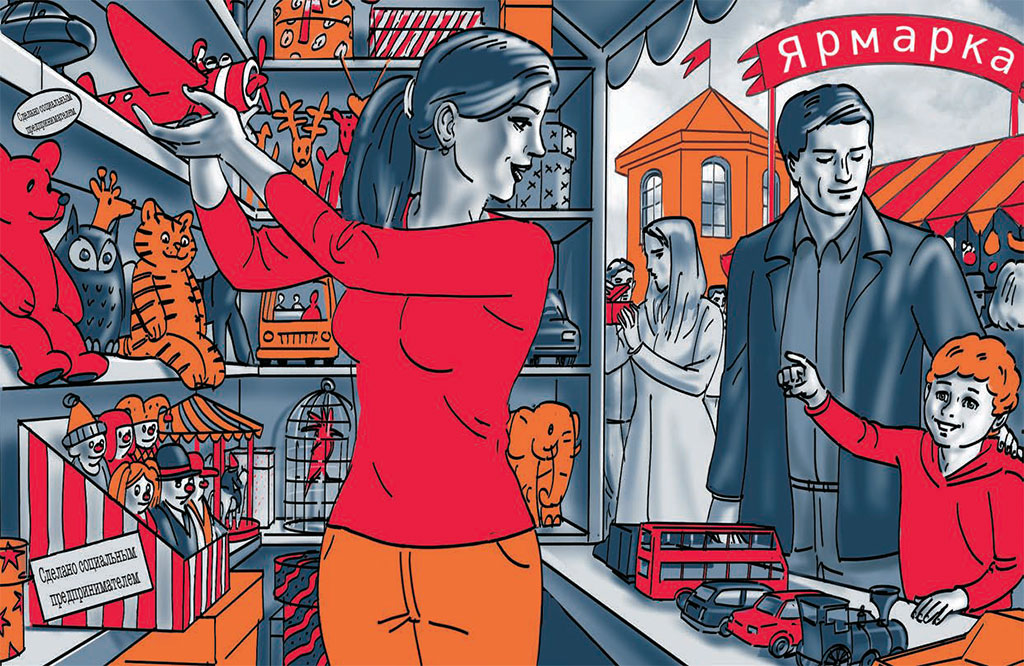
Подход к оценке социального возврата на инвестиции (SROI) активно используется во всем мире для социальных проектов, включая социальное предпринимательство. Благодаря SROI доноры и инвесторы получают не только понимание экономической устойчивости проектов, но и непосредственной пользы и значимости для людей, что и является задачей модели социального предпринимательства. В данной статье мы хотели бы рассказать, как и зачем проводилась оценка для проекта «Начни свое дело» компании «ОМК».

Юлия Ходорова
Руководитель направления исследований БФ «Культура благотворительности»
ЧТО ТАКОЕ СОЦИАЛЬНЫЙ ВОЗВРАТ НА ИНВЕСТИЦИИ (SROI)
Социальный возврат на инвестиции (SROI) – подход к анализу инвестиционной эффективности социальных проектов и программ, который позволяет измерять и учитывать ценность в широком смысле слова. Он представляет собой усовершенствованную модель финансового анализа «затраты-выгоды» (CBA) и позволяет сопоставить вложенные в проект или программу средства с ценностью социальных, экономических и экологических результатов, которые создает этот проект для людей[25]. Метод SROI основан на определенных принципах и стандартах.
Стейкхолдеры (люди, чьи интересы затронуты проектом) находятся в центре анализа SROI, что позволяет измерить изменения, действительно важные для людей и организаций, которые их достигают, и для которых они достигаются. В рамках анализа SROI для передачи ценности результатов для стейкхолдеров используются денежные единицы, что делает возможным расчет показателя «возврата на инвестиции» путем сопоставления суммы ценности всех результатов проекта со всеми инвестициями в его реализацию.

Например, соотношение 3:1 означает, что, вложив 1 рубль в некий проект или деятельность, мы получим 3 рубля в виде созданных этим проектом или деятельностью ценностей для людей.
Денежные единицы в социальном возврате на инвестиции – это единица измерения ценности, а не стоимости результатов, использование которой позволяет сравнить результаты проекта с вложенными в него ресурсами и сделать вывод о его инвестиционной эффективности.
Положительный показатель SROI больше 1, например, 2:1, говорит о том, что социальный проект имеет положительные результаты, которые в два раза превосходят по ценности сумму вложенных в него средств. SROI меньше единицы не обязательно говорит о том, что проект не эффективен, возможно, инвестиции в него еще не достигли точки «окупаемости» и требуется дальнейший анализ. И наконец, любое отрицательное значение SROI говорит о том, что проект неэффективен, потому что его отрицательное воздействие превосходит положительное.
Существуют два вида оценки социального возврата на инвестиции:
• оценочный (evaluative SROI) – когда коэффициент SROI рассчитывается ретроспективно на основании фактических результатов, которые уже были достигнуты;
• прогнозный (forecast SROI) – когда мы пытаемся спрогнозировать, какой объем социальных ценностей будет создан, если наша деятельность достигнет запланированных результатов.
Прогнозная оценка SROI особенно полезна на этапе планирования деятельности. Благодаря ей можно понять, как максимизировать воздействие социальных инвестиций и определить, какие показатели нужно будет отслеживать и измерять в ходе реализации проекта или деятельности.
Основная задача SROI – предоставить информацию инвесторам и социальным предпринимателям для принятия управленческих решений, управления результатами. Инвесторам анализ дает возможность увидеть различные сценарии развития проекта, скорректировать воздействие или методы работы проекта.
Подход к оценке социального возврата на инвестиции может быть использован как для больших масштабных проектов, так и для небольших предприятий, он универсален и может адаптироваться под конкретные задачи и ресурсы. Самая затратная часть анализа – это монетизация и построение модели SROI. Обычно именно эта часть интересует инвесторов и доноров. При этом во многих случаях достаточно ограничиться построением теории изменений, определением круга стейкхолдеров и результатов для них. Для стартапов и малых предпринимателей будет достаточно реализации первых нескольких шагов анализа. Такой анализ не потребует значительных усилий и ресурсов и будет очень полезен для понимания воздействия, оказываемого деятельностью предпринимателей.
Стоимость работы по оценке SROI зависит от масштаба проекта, его охвата по стейкхолдерам, по регионам. А также от той степени погружения, которая требуется заказчику, и от необходимости делать монетизацию и рассчитывать модель SROI. Как и в любом исследовании, большая часть ресурсов требуется на сбор данных, на проведение интервью, на вовлечение самих участников. Наиболее трудоемкими и затратными являются проекты по оценке инфраструктурных программ, грантовых конкурсов, длительных комплексных программ с широким фокусом воздействия.
Дополнительные расходы потребуются, если необходимо сделать независимую верификацию результатов оценки.
Руководство по применению SROI опубликовано на сайте организации-основоположника подхода Social Value International: https://www.socialvalueint.org/guide-to-sroi/.
ПРИНЦИПЫ SROISROI – подход, который допускает разнообразие используемых методов сбора и анализа данных при условии соблюдения единых принципов.
Таблица 1. Принципы SROI и их реализация в оценке программы «Начни свое дело»
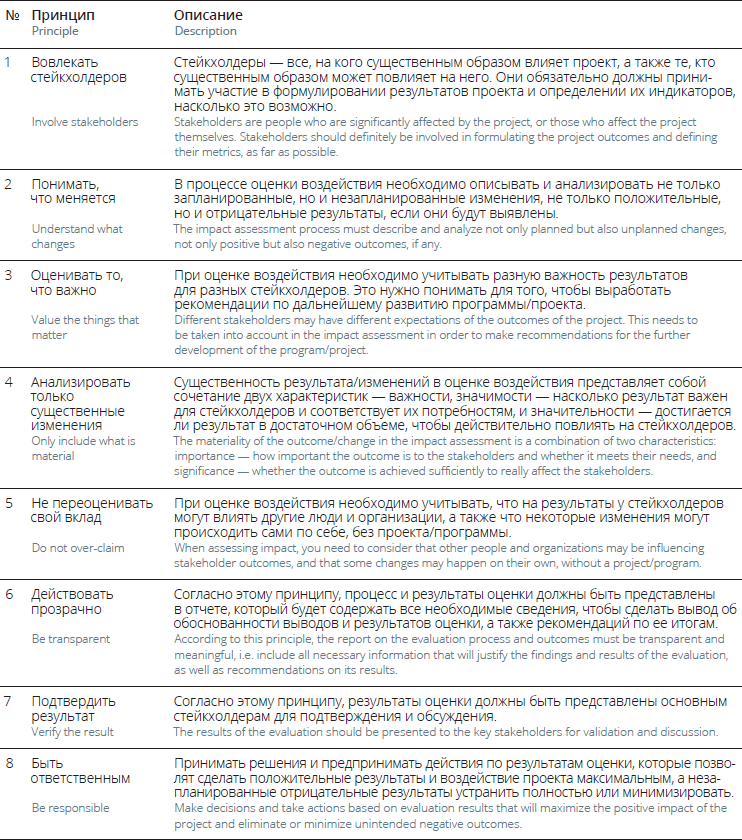
ЭТАПЫ ИССЛЕДОВАНИЯ И ВЗАИМОДЕЙСТВИЕ СО СТЕЙКХОЛДЕРАМИ
Рассмотрим реализацию принципов и подхода SROI на конкретном примере. Оценка была проведена для компании «ОМК», которая занимается поддержкой социальных предпринимателей в городах своего присутствия. Программа «Начни свое дело» реализуется с 2016 года, она была запущена последовательно в трех городах: Чусовой (Пермский край) – в 2016 году, Благовещенск (Республика Башкортостан) – в 2017 году и Выкса (Нижегородская область) – в 2018 году. Оценка социального возврата на инвестиции по программе «Начни свое дело» проводилась в мае-июне 2021 года и включала несколько этапов.
ВЫБОР ОБЪЕКТА ОЦЕНКИ И ОПРЕДЕЛЕНИЕ СТЕЙКХОЛДЕРОВВовлечение стейкходеров является основополагающим принципом SROI. Под стейкхолдерами понимаются все, на кого воздействует программа и кто воздействует на нее. Во внимание принимают довольно широкий круг стейкхолдеров, включая тех, которые не вовлечены непосредственно в деятельность проектов. Такой подход позволяет собрать больше информации, шире и глубже увидеть процессы. Однако на практике эксперты сталкиваются с различными ограничениями, связанными со сбором данных. Поиск оптимального баланса ресурсов и охвата стейкхолдеров, то есть глубиной оценки, – важная задача эксперта по оценке.
В нашем примере было принято решение включить в число стейкхолдеров программы непосредственно социальных предпринимателей, сотрудников, для которых они создали рабочие места за время реализации программы (сбор данных проводился через социальных предпринимателей), а также местные сообщества (сбор данных проводился через Центры инноваций социальной сферы в регионах и местные администрации).
Анализ SROI по программе «Начни свое дело» проходил в очень сжатые сроки, и с этим связаны серьезные ограничения в определении и включении в анализ существенных стейкхолдеров программы.
В таблице представлены основные стейкхолдеры программы «Начни свое дело», описано возможное воздействие на них и представлена информация о том, были ли они включены в анализ и почему (См. Таблица 2).
Поскольку социальные предприниматели являются основной целевой аудиторией программы «Начни свое дело», было принято решение сосредоточиться на них, а для других групп стейкхолдеров принимать во внимание при расчете SROI только чисто экономические результаты в виде налоговых отчислений СП и доходов людей, которых они трудоустроили. Такое решение соответствует первому принципу SROI – вовлекать стейкхолдеров – и пятому – не переоценивать свой вклад: поскольку фактически ни сотрудники СП, ни местные сообщества не были доступны исследователям, были учтены для них только те результаты, которые можно было установить без их непосредственного участия.
Таблица 2. Анализ стейкхолдеров программы «Начни свое дело»
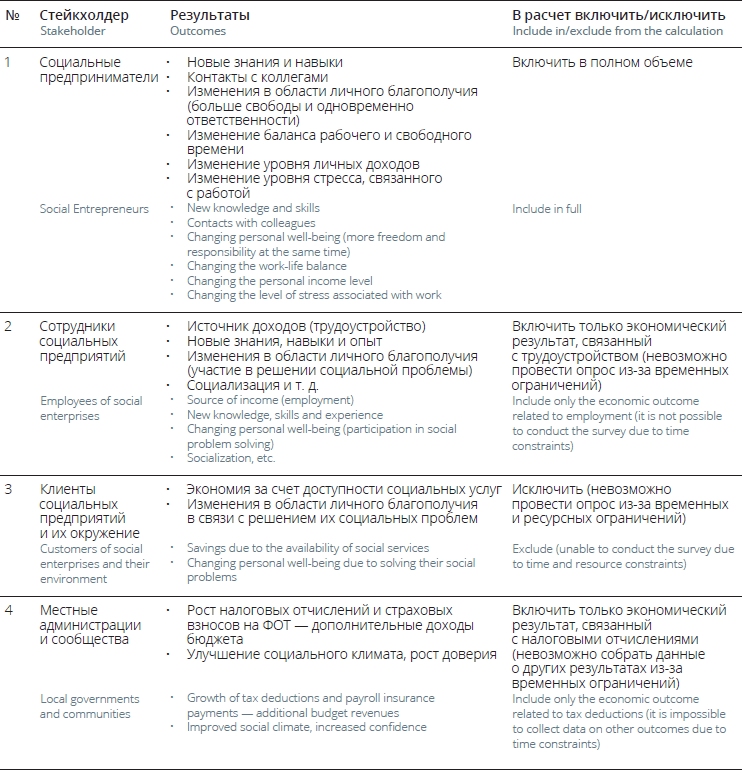
Кроме того, в анализ и расчеты не были ни в каком виде включены результаты для клиентов – пользователей товаров и услуг социальных предпринимателей, поскольку они также не были доступны исследователям.
При таком ограничительном подходе к результатам программы, исследователи приняли решение также скорректировать вклады в программу и не учитывать в основном расчете гранты и инвестиции в социальные предприятия из других источников. Таким образом, в качестве вклада в программу приняты только все расходы на реализацию программы со стороны компании «ОМК».
Таким образом, в анализ SROI включены полные данные о результатах программы у социальных предпринимателей и только экономические результаты для местных сообществ и сотрудников социальных предприятий.
ПОСТРОЕНИЕ КАРТЫ РЕЗУЛЬТАТОВНа основании данных, полученных из документов программы и интервью с ее сотрудниками в компании «ОМК», был подготовлен проект карты результатов программы для СП, который отражал основные направления деятельности и изменения, которые планировались в результате этих видов деятельности. Проект был проверен и уточнен со стейкхолдерами на следующем этапе работы.
На рисунке 1 представлена карта результатов программы «Начни свое дело», включенных в анализ по итогам качественного этапа исследования с учетом его ресурсных и временных ограничений.
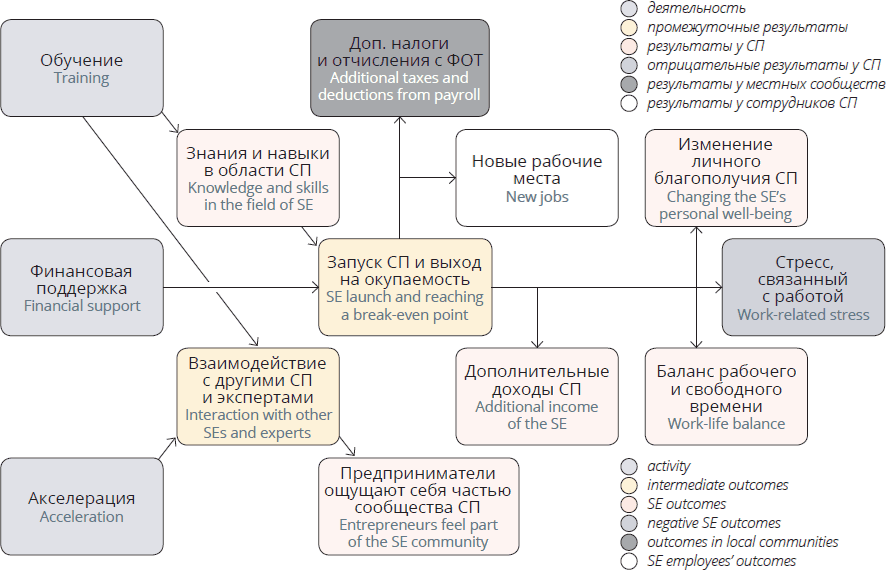
Рисунок 1. Карта результатов программы «Начни свое дело», включенных в анализ
СБОР КАЧЕСТВЕННЫХ ДАННЫХ
Целью этого этапа является уточнение результатов, получение информации о том, как достигаются изменения у стейкхолдеров, какие положительные и отрицательные результаты связаны с деятельностью.
В рамках качественного этапа исследования были проведены интервью с представителями местных администраций и Центров инноваций социальной сферы регионов, в которых реализуется программа, а также с экспертами программы и фокус-группы с социальными предпринимателями. Сбор информации в фокус-группах на данном этапе исследования проходил в соответствии с принципом насыщения – когда большая часть информации на фокус-группах стала повторяться, а доля новых существенных фактов стала минимальной, этап был завершен.



